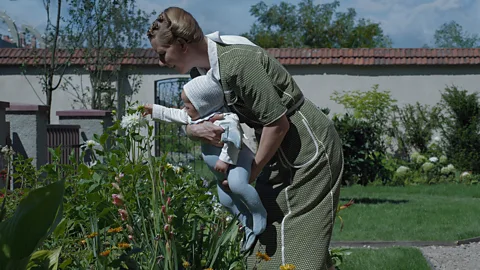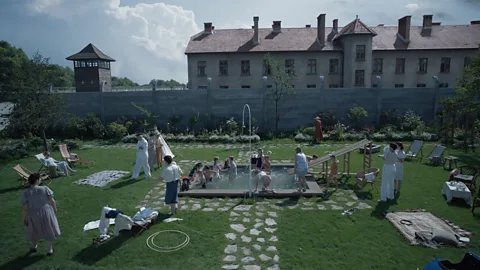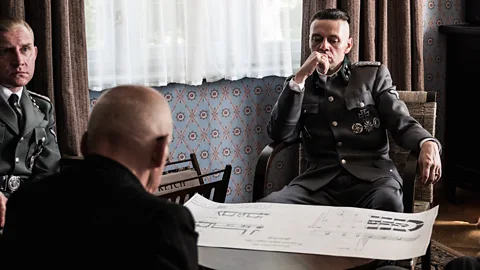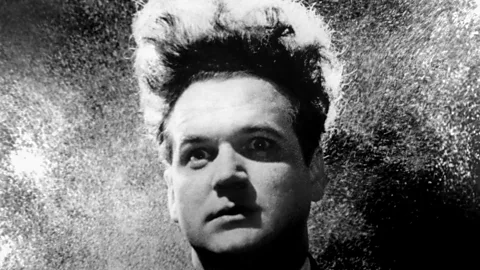By Laura MartinFeatures correspondent

 A24
A24
The Holocaust drama is chilling audiences – because of what they hear, not see. Sound designer Johnnie Burn discusses recreating the sounds of the concentration camp.
A film about the Holocaust, 10 years in the making, The Zone of Interest has been winning acclaim as one of the most starkly chilling depictions of human brutality ever created.
It is one of this year’s leading awards contenders, with nine nominations for this Sunday’s Baftas, and five for this year’s Oscars, where, if it did land the top prize, it would certainly be the most shocking best picture winner in history. Yet a lot of its power lies in what’s heard, not what’s seen.
More like this:
– TV review: A new drama about Coco Chanel and the Nazis
The movie opens with a black screen. For an unnerving couple of minutes, there’s no picture, just waves of a haunting atonal drone that eventually fades out. This is the first indication of how important sound will be in this film. Listen, it seems to suggest, and don’t be blinded by what you’re about to see. “I wanted viewers to realise that they’re submerging,” the director, Jonathan Glazer, told Rolling Stone of the intro. “It was a way of tuning your ears [in] before you tune your eyes to what you’re about to view.”

 A24
A24
The images that follow shortly after are cheerful, relaxed scenes of a young German family on day out in a bucolic setting, and set the grimly jarring tone for the rest of the film. The early reveal is that the family is in fact real-life Nazi commander Rudolf Höss, his wife Hedwig and their five children, while their stately home with its “paradise garden” backs on to the wall of the Auschwitz death camp. Höss is orchestrating and overseeing the construction of the gas chambers which would go on to kill thousands of Jewish people, just metres from their family home.
It’s at this point that the film cleaves into two. As Glazer has explained: “There is the movie you see, and there is the movie you hear.” While the visual element – described by Glazer to the Guardian as “Big Brother in the Nazi house” – largely concerns itself with the banal day-to-day activity in the family home, with the characters callously ignoring or joking about the atrocities next door, the sound tells a frighteningly different story.
With the sound, we’re deliberately ambiguous: Is that a scream or is it a train whistle? – Johnnie Burn
The film’s score was composed by Mica Levi – also responsible for Glazer’s last film, Under the Skin – but is sparingly used; rather, it’s the non-musical sound design, featuring the recreated sounds of Auschwitz and created by the now Bafta and Oscar-nominated Johnnie Burn, with mixing by Tarn Willers, that is most prominent. The sounds we hear coming from behind the camp wall as the Hösses go about their business are, like the film’s subject, horrifying. There are the prisoners’ blood-curdling screams, the guards’ abusive yells, and gunshots. There’s the disturbing mechanical thrum of what we know are the gas chambers and the ever-active crematorium. None of the violence and murders are seen on screen, leaving the viewer to fill in the gruesome blanks of what’s really going on.
“[With the sound] we’re deliberately ambiguous,” Burn tells BBC Culture. “Is that a scream or is it a train whistle? Or is it the baby in the house? Depending on what mood you’re in, you might hear it differently on different occasions. Your mind goes off and starts making its own visions, so we’re drawing pictures in people’s heads based on a collective mental imagery and knowledge that people already have.”
The plan from the outset
When Glazer approached Burn, after also working with him on Under the Skin, he was very resolute about what the film shouldn’t be about: “Jonathan said to me: ‘It’s mandatory for me, I don’t want to show the images that people have already seen. There’s no point in doing that, so sound is how we’ll present [the atrocities]’,” Burn says. “It was only when we got into post-production that we realised that to represent the industry and the scale of the place, the sound had to be quite a comprehensive, permanent force.”

 Getty Images
Getty Images
The pressure was on from when Burn – who also worked on the sound design for Nope and Poor Things – joined the production, he says. “I felt a huge responsibility on the one hand to accurately represent the victims and survivors of the Holocaust, and on the other to absolutely make sure that the film works.”
If the Höss family life part of the film was set to be a twisted fantasy (as Burn recalls, the crew filming these domestic scenes asked Glazer: “When are you going to film the bad stuff; it’s a Holocaust movie?”), the sound would act to reveal the truth of the story. What followed was painstaking levels of research to be able to carry out Burns and Glazer’s visions for the “two” films.
A starting point was all the basics, like making sure that the sounds of motorbikes were of that time and that the birds and the bees were right for the season and location. Burn then read through many witness testimonies from Auschwitz survivors, as well as having access to unpublished statements and documents in the Auschwitz-Birkenau State Museum on the site of the camp in Poland, also where the movie was filmed. “A lot of those contained direct references to sound,” he says. “People mentioned the sound of the electric fence, that there were music orchestras playing; the sound of the wooden clogs.” However, above and beyond that he said, the witness testimonies contained lots of vivid descriptions of murder and torture, from which Burn could readily imagine the sounds himself – of the shout of a guard, the crack of a whip or gun.
We found the sound of the camp’s machinery became a really good shorthand to take the place of an awful lot of other gruesome sounds that we had – Johnnie Burn
As part of the sound library he created for the film, Burn needed to make substantial field recordings that could pass for credible impressions of the horrors needed to be conveyed. However, he explains: “If I said to someone: ‘Act like you’re dying, or pretend you’ve been shot’, if I put any wooden acting on such a documentary-like film, it would [sound] really wrong. It was about trying to find things in the real world that actually happened, and record those and re-appropriate them.

 A24
A24
“So for example, a lot of people arriving at the camp at that time were French, as that’s where the trains were coming from, and about a year-and-a-half ago there were protests and riots in Paris. So my team and I went and we mingled with hidden microphones in Paris and recorded people shouting. To portray the drunken night-time revelry of the guards we went to the Reeperbahn in Hamburg to record drunken, shouting German voices.”
Judging the edit
Burn worked on the sound edit for a year-and-a-half, matching the sounds to the images. Were there moments at which he worried about making it too horrifying? “Absolutely,” he says. “It was a difficult line to tread as to how far to take [the sound], and it took about three or four months to calibrate the ebb and flow of it. But we had to listen to the film from the beginning each time if we wanted to judge something one hour in to understand how it affected us. Definitely there were times when we had too much [sound] in. We only introduced the constant sound of the machinery of the camp about two or three months before the end, but we found it became a really good shorthand to take the place of an awful lot of other gruesome sounds that we had. It allowed us to take out any [too] sensational stuff.”
The full score that Levi wrote was also heavily cut, as was the idea of having more abstract sounds throughout, on top of the naturalistic ones, except in the several surreal, dream-like black and white scenes featuring a young girl hiding fruit for the prisoners. That was because ultimately, given the documentary-like nature of the film, “we felt like it was saying it didn’t really happen,” Burn says.
Sound is not something you can rationalise as easily as a picture, and that gets under your skin – Johnnie Burn
The power to create a truly disturbing watch through sound has been evident across cinema history. Think of the eerie hiss of oxygen and astronaut Bowman’s panicked breathing in the final scenes of 2001: A Space Odyssey; or the nightmarish set-up of the diner scene in Mulholland Drive where the jump-scare of a mysterious figure appearing from behind a wall seems to suck all of the surrounding sound out in a vacuum. Burn cites another David Lynch film, Eraserhead, as having one of the most impactful yet discomforting sound designs, with the constant fuzz and its wildly changing and echoing pitch making it a truly confusing and uncomfortable watch.
Then there are those films in which banal, everyday noises can become chilling, such as the Coen brothers’ No Country For Old Men, memorable for sounds like the slow pad of boots on the pavement, and a squeaking door slowly opening before an unwelcome reveal. Similarly, “normal” sounds are used to terrifying effect in lo-fi horror classic The Blair Witch Project. Hearing shallow breathing and rustling leaves underfoot in a film about a jogger running through a park in daylight wouldn’t give cause for panic, but in the context of a raw mockumentary of a ghost story that plays on viewers being literally in the dark. Imaginations run wild with this sound.

 Alamy
Alamy
Sound has the power to truly rattle us, and its effect is more visceral in some ways than what we see, as Burn explains. “Sound paints a picture that’s so personal to you and it does it in a way that connects more with your subconscious and your limbic system,” he says. “It’s not something you can rationalise as easily as a picture, and that gets under your skin because you can fool someone’s eyes so much more easily than you can fool their ears.”
He adds: “The eyes react slower than the ear. The way the brain processes the sound as it goes into the stem of the brain – you can have an instant reaction to a sound long before you have time to rationally process it, and [that] can really scare the hell out of you.”
Shaken-up viewers of The Zone of Interest have posted on social media about the impact of the film’s sound, calling it “chilling“, “nightmarish” and “soul-shattering“. One person commented: “I genuinely feel like they could put a trigger warning on The Zone of Interest, for the sound design.” The film ends with the audience typically in stunned, shell-shocked silence as a closing musical track – an assault of choral wailing in crescendo by Levi – plays out. It’s an incredibly difficult watch, and working on it day in, day out for several years took its toll on Burn too. “It was hard,” he says. “A few of us who worked on the post-production side of the film, the bit where we stitch together all the grim stuff, we all suffered a bit. We were quite low. It’s a horrible place to be in and not something I’d ever really want to do again.”
After watching the film, I reflected on how, as it progressed, I had subconsciously begun to become desensitised to the sounds, or partially blocked them out. This is a common reaction, Burn says. “I experienced that too – it’s exactly for that reason the sounds in the film actually get marginally louder as the film goes on because we dial [them] out. It’s really weird, as a human you end up thinking, ‘it’s just another scream, I can dial that out, fine’.”
This very fact acts as a stark and disturbing allegory for the film as a whole, Burn adds: “That’s what Jonathan’s trying to say, we’re all on that slippery slope [to desensitisation]. The film is about what humans do to other humans, so let’s try and get rid of this violence.”
The Zone of Interest is out in cinemas in the US and UK now
If you liked this story, sign up for The Essential List newsletter – a handpicked selection of features, videos and can’t-miss news delivered to your inbox every Friday.
If you would like to comment on this story or anything else you have seen on BBC Culture, head over to our Facebook page or message us on Twitter





